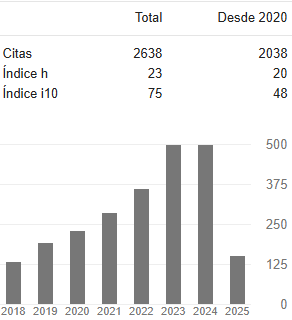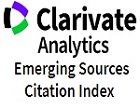Formulación de un modelo para determinar las zonas actuales y potenciales de cultivo de aguacate Hass (Persea americana Mill) en el departamento de Risaralda a partir de variables edafoclimáticas y de calidad del fruto
DOI:
https://doi.org/10.31908/19098367.2993Palabras clave:
Aguacate Hass, Aprendizaje Automático, Random Forest, Zonas Potenciales de CultivosResumen
La agricultura es uno de los pilares fundamentales de cualquier población a nivel mundial y el manejo adecuado de información permite tomar decisiones oportunas para el avance de cualquier empresa que el ser humano desarrolle. Los entes de gobierno nacional y departamental apoyan renglones de la agricultura que emergen como una buena oportunidad de aumentar niveles de producción y de comercialización de productos [1], como es el cultivo del Aguacate (Persea americana Mill) variedad Hass. Entre los desafíos que tiene este tipo de cultivo, es encontrar zonas potenciales de siembra y productividad, con el fin de contribuir en desarrollos tecnológicos en el sector agrario, siendo beneficiarios los cultivadores de Aguacate Hass del departamento de Risaralda. Por lo tanto, con este estudio se propone formular un modelo que permita determinar zonas actuales y potenciales de cultivos de aguacate (Persea americana Mill) variedad Hass, en el departamento, con base en variables edafoclimáticas y de calidad del fruto, aprovechando las tendencias actuales de la agricultura de precisión, incluyendo técnicas derivadas del Aprendizaje Automático, como la utilización de algoritmos de Aprendizaje Supervisado, entre los cuales esta Random Forest
Descargas
Referencias
Perfetti, J.J., Bravo-Ureta, B.E., García, A., Pantoja, J., Delgado, M., Blanco, J., Jara, R., Moraga, C., Paredes, G., Naranjo, J., et al.: Adecuación de tierras y el desarrollo de la agricultura colombiana: políticas e instituciones. Fedesarrollo 447, 456 (2019)
El-Bendary, N., Elhariri, E., Hazman, M., Saleh, S.M., Hassanien, A.E.: Cultivation-time recommender system based on climatic conditions for newly reclaimed lands in egypt. Procedia Computer Science 96, 110–119 (2016)
Singh, R., Kumari, T., Verma, P., Singh, B.P., Raghubanshi, A.S.: Compatible package-based agriculture systems: an urgent need for agro-ecological balance and climate change adaptation. Soil Ecology Letters 4(3), 187–212 (2022)
Dreher, M.L., Davenport, A.J.: Hass avocado composition and potential health effects. Critical reviews in food science and nutrition 53(7), 738–750 (2013)
Ramírez-Gil, J.G., Ramelli, E.G., Osorio, J.G.M.: Economic impact of the avocado (cv. hass) wilt disease complex in Antioquia, Colombia, crops under different technological management levels. Crop protection 101, 103–115 (2017)
MADR, M.d.A.y.D.R.: CADENA DE AGUACATE, Indicadores e instrumentos. Lect Econ. 2019;52(52):165–94 (2019)
Martínez, D.H.F., Galvis, C.P.U.: Tic para la investigación, desarrollo e innovación del sector agropecuario (2018)
Orozco, O. A., Llano Ramírez, G.: Sistemas de información enfocados en tecnologías de agricultura de precisión y aplicables a la caña de azúcar, una revisión. Revista Ingenierías Universidad de Medellín 15(28), 103–124 (2016)
Van Klompenburg, T., Kassahun, A., Catal, C.: Crop yield prediction using machine learning: A systematic literature review. Computers and Electronics in Agriculture 177, 105709 (2020)
Machado, D.F.T., Silva, S.H.G., Curi, N., Menezes, M.D.d.: Soil type spatial prediction from random forest: different training datasets, transferability, accuracy and uncertainty assessment. Scientia Agricola 76, 243–254 (2019)
Jyothika, P., Ramana, K.V., Narayana, L.: Crop recommendation system to maximize crop yield using deep neural network.
Vite Cevallos, H., Carvajal Romero, H., Barrezueta Unda, S.: Aplicación de algoritmos de aprendizaje automático para clasificar la fertilidad de un suelo bananero. Conrado 16(72), 15–19 (2020)
Katarya, R., Raturi, A., Mehndiratta, A., Thapper, A.: Impact of machine learning techniques in precision agriculture. In: 2020 3rd International Conference on Emerging Technologies in Computer Engineering: Machine Learning and Internet of Things (ICETCE), pp. 1–6 (2020). IEEE
Geetha, V., Punitha, A., Abarna, M., Akshaya, M., Illakiya, S., Janani, A.: An effective crop prediction using random forest algorithm. In: 2020 International Conference on System, Computation, Automation and Networking (ICSCAN), pp. 1–5 (2020). IEEE
Pozdnoukhov, A., Kanevski, M.: Machine learning algorithms for analysis and modeling of geospatial data. In: Annual Conference of International Accociation for Mathematical Geology (IAMG 07), Beijing, China, 25-31 August (2007)
Carranza, J.P., Salomón, M.J., Piumetto, M.A., Monzani, F., MONTENEGRO CALVIMONTE, M., Córdoba, M.A.: Random forest como técnica de valuación masiva del valor del suelo urbano: una aplicación para la ciudad de río cuarto, córdoba, argentina. In: Congresso Brasileiro de Cadastro Técnico Multifinalitário-COBRAC (2018)
Sekulic, A., Kilibarda, M., Heuvelink, G.B., Nikoli ́c, M., Bajat, B.: Random Forest Spatial Interpolation. Remote Sensing 12(10), 1687 (2020)
Mariano, C., Monica, B.: A random forest-based algorithm for data-intensive spatial interpolation in crop yield mapping. Computers and Electronics in Agriculture 184, 106094 (2021)
Kuhn, M. Johnson, K. Kuhn, M, Johnson, K. Classification trees and rule-based models. Applied predictive modeling, 369–413 (2013)
Talebi, H., Peeters, L.J., Otto, A., Tolosana-Delgado, R.: A truly spatial random forests algorithm for geoscience data analysis and modelling. Mathematical Geosciences 54, 1–22 (2022)
Rajeshwari, M., Shunmuganathan, N., Sankarasubramanian, R.: Performance of soil prediction using machine learning for data clustering methods. Journal of Algebraic Statistics 13(2), 858–864 (2022).
FAO - GAEZ Data Portal.: Data sheet Persea americana. Available from: https://gaez.fao.org/pages/ecocrop-find-plant (2023)
Descargas
Publicado
Número
Sección
Licencia
Derechos de autor 2024 Entre Ciencia e Ingeniería

Esta obra está bajo una licencia internacional Creative Commons Atribución-NoComercial 4.0.



















